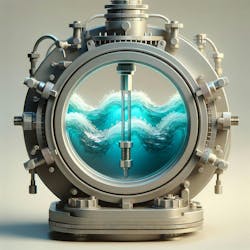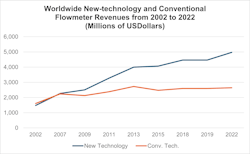‘New-technology’ and conventional flowmeters: relative growth over the years
July 25, 2024
5 min read
In May 2024, Flow Research published the 9th Edition of a study on the worldwide flowmeter market, which included all technologies. It is a significant edition of the study because it represents our first look at the entire flowmeter market since the COVID-19 pandemic. Our approach was to study the market for each flowmeter type individually and then assemble all these individual markets into a picture of the total flowmeter market, worldwide and by region, in 2022 and 2023.
It is interesting and instructive to see how the flowmeter market has changed since 2019, which was the base year for the study preceding this one. One of the main differences between the two years, 2019 and 2022, is the extent to which “new-technology” flowmeters continued to dominate the flowmeter market, a consistent trend in the flowmeter market for the past 20 years.
What are new-technology flowmeters?
I first introduced the term new-technology flowmeters in an article in Control in February 2001. In the article, I identified Coriolis, magnetic, ultrasonic and vortex meters as new-technology meters. The following month, I wrote another article in which I classified “traditional technology” flowmeters: differential pressure, positive displacement, turbine, open channel, variable area and thermal. After extensive discussions with John Olin, founder of Sierra Instruments, I reclassified thermal flowmeters from traditional to new-technology meters. I explained this decision in an article in the October 2003 of Control. This classification remained the same since then, except, for simplicity, I changed the category of traditional technology flowmeters to “conventional” flowmeters in 2022.
What distinguishes new-technology flowmeters from conventional flowmeters is that they were introduced after 1950, are more the focus of product development than conventional flowmeters, perform better than conventional flowmeters in accuracy and reliability, have reduced maintenance requirements, and do not have moving parts. These features make them attractive to end-users, especially for new installations. Conventional flowmeters have an advantage in installed base since some of them have been around since 1793.
A 20-year trend
When Flow Research began researching the worldwide flowmeter market, revenues from conventional flowmeters exceeded those of new-technology flowmeters. This was shown in the 1st Edition of The World Market for Flowmeters, published in 2003. In the 2nd Edition, with a base year of 2007, the two groups were almost equal. Since that time, new-technology revenues have exceeded revenues from conventional flowmeters. The accompanying chart shows the trend over 20 years.
Why has the new-technology flowmeter market overtaken and consistently outpaced the conventional flowmeter market over the past 20 years? There are many reasons for this.
- The two leading revenue-generating flowmeters—Coriolis and magnetic—are both new-technology flowmeters.
- Ultrasonic, the fastest growing type of flowmeter, is in the new-technology camp.
- While positive displacement flowmeters are used to measure the flow of refined fuels, many of them are used for lower-cost gas and water utility applications.
- Although large turbine meters are widely used for custody transfer of natural gas, they are also used for gas and water utility applications. Here they compete with positive displacement, differential pressure and ultrasonic meters.
- Most conventional flowmeters have moving parts and/or are subject to wear. End-users today are selecting flowmeters with limited maintenance issues. Both positive displacements and turbine meters have moving parts, while orifice plates are subject to wear.
- Coriolis and ultrasonic inline meters have the highest accuracy of any flowmeters. They are used for custody transfer of petroleum liquids and natural gas. While Coriolis meters perform well in line sizes below 6 inches, ultrasonic and turbine meters have the advantage in line sizes above 6 inches.
- Differential pressure, positive displacement and turbine meters have an advantage in installed base because they have been around so long. However, this advantage is not enough to overcome the technological advantages of new-technology meters.
- Even though magnetic flowmeters cannot measure the flow of steam, gas or petroleum liquids, they are the meter of choice in the water and wastewater market. They also are used in pulp and paper, metals and mining, and sanitary applications within the chemical and food processing industries. Magnetic flowmeters have linings that enhance their versatility and make them applicable for many different types of liquids.
Will this trend continue?
The trend towards new-technology flowmeters is likely to continue for the foreseeable future. Major suppliers invest heavily to bring advanced technology to Coriolis, ultrasonic and other new-technology meters, including advanced diagnostics, new and more durable materials of construction, breaking line-size meter barriers, and adding new communication protocols to their flowmeters. While additional research and development is likely to result in higher prices for some meters, end-users will pay for greater accuracy, reliability and redundancy.
One area where conventional flowmeters still have an edge is in the number of units sold. While new-technology meters maintain a clear revenue margin, more conventional meters are sold each year than new-technology meters, because many conventional meters such as positive displacement, turbine and variable area are lower in cost, and because end-users do not always need the high performance of new-technology meters. The net result is that all these flowmeters will be around for many years to come.
For more information on the worldwide flowmeter market and recent Flow Research studies, visit www.flowvolumex.com or www.flowresearch.com.
About the Author

Jesse Yoder
Columnist
Jesse Yoder is founder and president of Flow Research Inc., which conducts market research studies in a wide variety of areas, including the flowmeter market.
Sign up for our eNewsletters
Get the latest news and updates

Leaders relevant to this article:

